Ford Fiesta ST 2019 long-term review
 The latest hot supermini from the blue oval joins our fleet - is it the best of a brilliant breed?
The latest hot supermini from the blue oval joins our fleet - is it the best of a brilliant breed?
Why we’re running it: To see if Ford’s hottest supermini can successfully pick up the baton from its class-topping predecessor
Month 2 - Month 1 - Specs
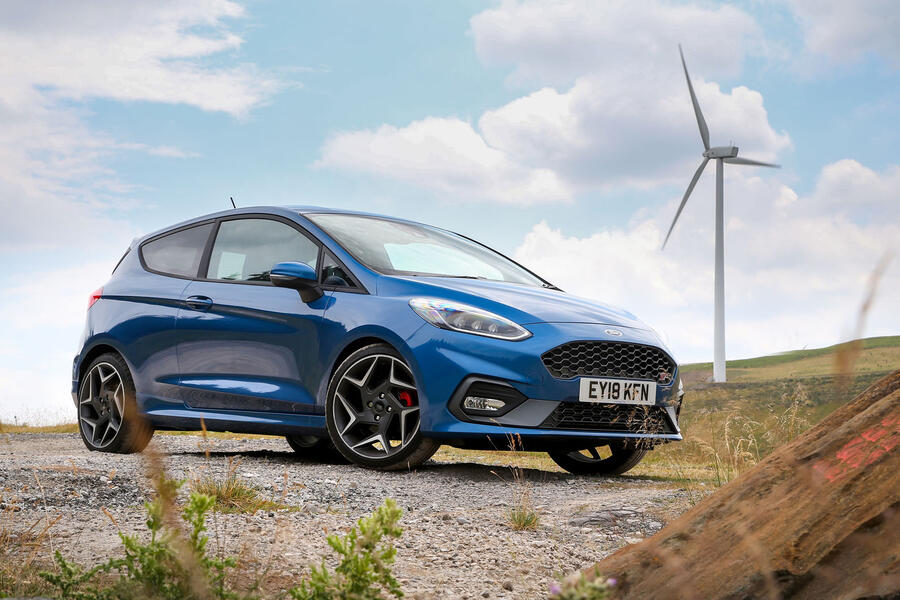
Life with a Ford Fiesta ST: Month 2
A return trip to Leeds and a back-to-back drive with a past class master - 16th January 2018
On the first day back at work after a week off for Christmas the Fiesta provided me with the greatest possible present for the morning commute: the Waze navigation app now works with the infotainment system.
No longer do I need to balance my phone precariously in the car’s centre console to view the app: a simple glance at the 8.0in touchscreen is now all that’s needed. For those of us that use our mobile for navigation, the development is a significant one, and it was a welcome boost to the ST’s already generous level of convenience.
A few weeks earlier our three-door had already scaled new heights in proving its maturity over the old ST when, on a trip to Leeds, it officially achieved the best mile-per-gallon figure of any long-termer I’ve run while contributing to Autocar. A 38mpg average might not sound like much cause for celebration, but on a weekend that involved a sprint up the M1, dozens of miles around Leeds’ inner roads and a quick jaunt on a country route, it’s highly impressive. It’s evidence of the effectiveness of the 1.5-litre triple’s ability to run on just two cylinders and its low-down grunt that negates the need for the engine to be worked hard.
These traits do come with their own drawbacks, of course. The turbocharged motor responds so quickly from low down that, perhaps inevitably, exploring the top end is less rewarding. Mostly this is because there’s simply less of it to explore: you’ll bounce into the limiter at just over 6250rpm. In isolation, and once you get to know the engine, this is of little concern, and you instinctively change up a gear when the bassy three-pot reaches its upper realms. But if you’re used to driving a hot hatch with an elastic top-end, the otherwise impressive engine might feel a little capped.
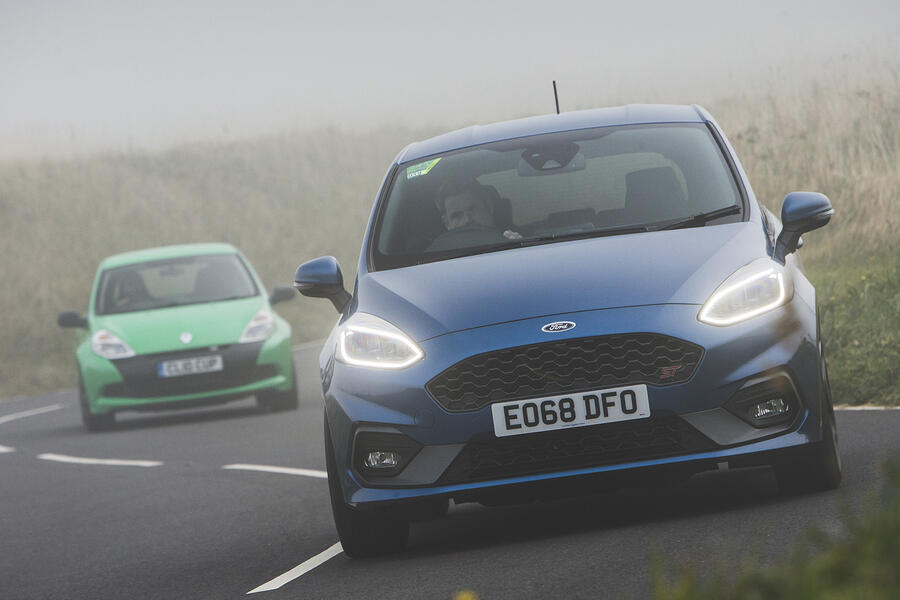
This was certainly the case on a recent back-to-back drive with a former Autocar hot hatch champion, namely a 2010 Renault Sport Clio 200 Cup. The ageing French car lacked a large number of creature comforts that come as standard on our Blue Oval hatch, meaning it was a far less comfortable place in which to be on an icy winter morning. But as soon as the oil temperature was up and the road conditions improved, the 2.0-litre-engined Clio’s natural sporting ability was clear. Its engine, for starters, begged to be revved, while its chassis felt racy and planted compared with the Fiesta ST’s more supple set-up.
Still, the ST was definitely quicker thanks to its broader torque window and grip advantage, partially helped by the use of its more extreme Michelin Super Sport tyres compared to the discontinued 200 Cup’s ContiSport Contact 5s. On cold asphalt, the Quaife front differential, included as part of the Ford’s optional Performance Pack (£850), was a godsend, finding grip where there really shouldn’t have been much and enabling the power to be applied earlier and with more aggression. The Clio, even with less grunt to juggle, struggled to compete and felt comparably nervous when asked for both steering angle and traction.
This drive gave me a chance to test the ST’s engine modes, which have so far divided opinion. I’m still firmly lodged in the camp that doesn’t see the point of them, because – aside from coaxing a couple of pops from the exhaust when you lift the accelerator – there are no real benefits to switching from Normal.
The only real argument for using Sport is a slight decrease in intrusion from the electronic stability control, but even this feels like a minute change. I know this opinion exists outside of Autocar HQ, too, because reader Paul Mason, an ST owner, messaged me to say he “defaults to Normal mode as this is usually sufficient and doesn’t make the car any less fun”. Not that this is a bad thing. It’s quite the opposite, actually.
Love it:
APPY NEW YEAR The addition of the Waze navigation app gives our Fiesta’s infotainment a key advantage over rival alternatives.
Loathe it:
MORE OR LESS POINTLESS Very occasionally the keyless entry doesn’t work until you pull the fob out of your pocket and wave it next to the door handle.
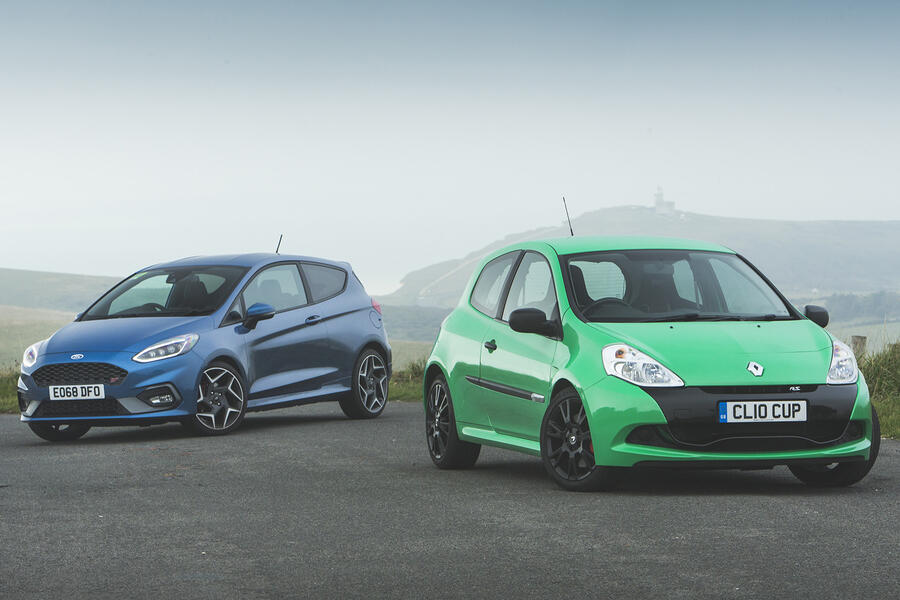
Mileage: 5378
Sensitive in all the right places - 27th December 2018
One of the ST’s best traits is the responsiveness of its engine. It pulls strongly from barely over 1000rpm, but the most satisfying thing is the pace at which it reacts to the smallest movements of your big toe. Perhaps it’s just a hypersensitive throttle map, but it enhances the connection to the engine and makes the car feel light on its toes.
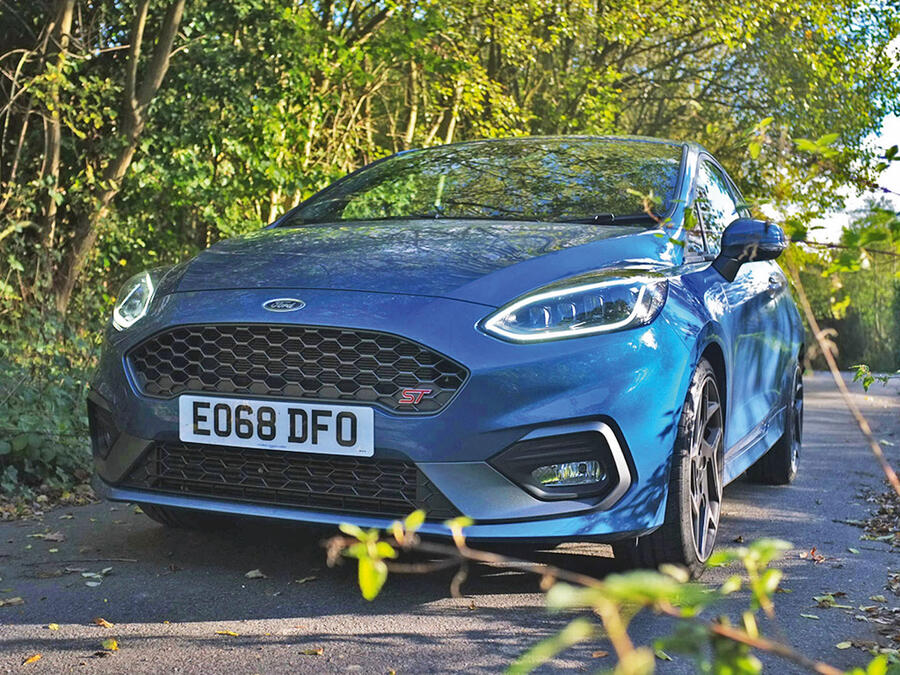
Mileage: 4162
Life with a Ford Fiesta ST: Month 1
Another one? Here’s why we wouldn’t, shouldn’t and couldn’t be without a hot Ford - 28th November 2018
Another Fiesta already, you ask? Well yes, this is the best-selling car in the UK by a long shot (as of October the Fiesta racked up 79,416 sales to the second-placed Volkswagen Golf’s 52,162) and there are many versions that each slot into their own niche. Of course there wasn’t going to be a Fiesta-shaped hole in the Autocar fleet for long.
Anyway, this particular one’s worthy of your attention because it’s the top dog, the halo model. Out of all the Fiestas, this is the one that has the best potential to get people like us wandering into a dealership asking for a brochure and test drive, even if we don’t really need a new car right now. The latest arrival on our fleet is a fully-fledged Fiesta ST. Yippee.
We won’t need to delve into too much detail to explain why we’re so excited because the ST has already proved itself as brilliantly fun to drive. You might recall it won our Junior Handling Day contest in the summer, which is impressive for a car that is neither the most potent nor most focused in its class. Anyone can jump into an ST and have a giggle, which is what it’s all about really, isn’t it?
Well, no, not really. It’s only part of the puzzle. Hot hatches have to be hot – and the ST is that – but they also have to be hatches. This means they arguably have the hardest job on the market: to be extremely practical, easy to drive and comfortable enough for daily use, while also being quick, playful and, hopefully, a bit silly. Oh, and they must remain affordable and cheap to run. The pressure’s even higher if your predecessor was the best hatch of its class, or if you rivals are supremely talented.
Unfortunately for our ST, that is exactly its case. The previous ST, particularly the ST200 run-out variant, was much-loved and still stands as one of the most enthralling front-wheel drive cars. It faced a tough bunch of rivals but the new car arguably has it even harder, because today there’s a much better Volkswagen Polo GTI, the Mini Cooper S has received a list of improvements to enhance its appeal further and there’s a newcomer in the Toyota Yaris GRMN that is bloody good fun. Our Fiesta ST must keep us on side over the coming months as winter sets in, while also resisting the pressure from its fellow sporty hatchbacks and anything else that crops up between now and spring.
No doubt a key topic for investigation will be the ST’s use of a 1.5-litre three-cylinder engine. That’s about 100cc and a cylinder down on the old car’s 1.6, which you might think will lead to a higher stressed engine more dependant on the boost provided by its turbocharger.
Certainly that’s been the case with plenty of other downsized engines in recent years, but the ST has cylinder deactivation technology up its sleeve. Impressively, it means it can run on just two cylinders in low-load situations, which might help explain the claims for 47.1mpg combined and 55.4mpg extra urban. Those are numbers never before achieved by a hot Fiesta; in fact, our experiences of the previous generation left both figures at least 10mpg lower. This tester’s wallet hopes the claimed figures are accurate.
As a top-of-the-range ST-3, our car comes loaded with kit. As standard it gets 18in five-spoke wheels with a two-tone machined finish, red brake calibers and rear privacy glass, as well as part-leather Recaro sports seats, a rear view camera and keyless entry.
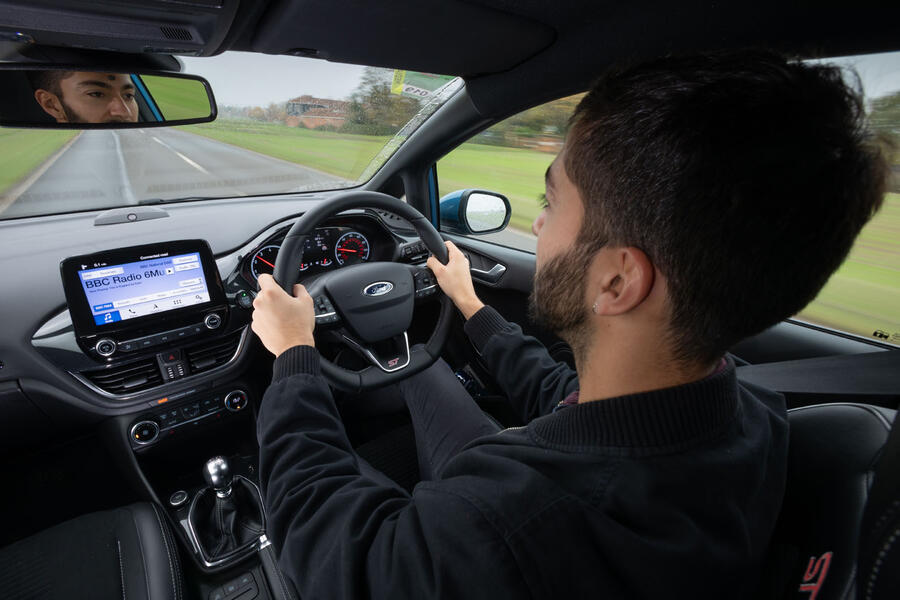
There’s also an 8.0in touchscreen with Sync3 infotainment, including Apple Carplay/Android Auto. But the key features that should really set our car apart are the options of the ST Performance Pack (£850), which includes a Quaife limited-slip differential, as well as full LED headlights (£600) and a B&O Play premium audio system (£350), complete with a sub woofer in place of the spare wheel. These features have potential to substantially enhance fun, usability and in-car entertainment. They also help to push our car’s on the road price up to £24,515, almost £3000 more than the standard ST-3 figure.
The venue for the handover of our ST was none other than the Service Park of Wales Rally GB, where M-Sport fielded its Fiesta World Rally Championship cars. It was hard to not get revved up when the Ford keys were handed over as we stood beside five-time WRC champ Sébastien Ogier’s Fiesta. Okay, so our car lacked the big wing and protruding aerodynamic bodywork, but it still managed to catch the gaze of several M-Sport mechanics who you might imagine to be bored of the Fiesta form. It seemed they were all eager to see the ST’s top-spec interior and hear the burble from its exhaust note in its naughtiest Race mode. Some even jested that they were thinking of getting one.
Does this motorsport link go deeper than the matching bodywork applied to the road ST and its WRC counterpart? Probably not. For some it might help to make the ST experience more exciting, but in truth almost all people interested in a hot Fiesta are unlikely to be drawn over by the model’s involvement in the WRC. Exactly what does attract – or deter – people to Fiesta ST ownership is what we’ll be investigating over the coming months.
Sam Sheehan
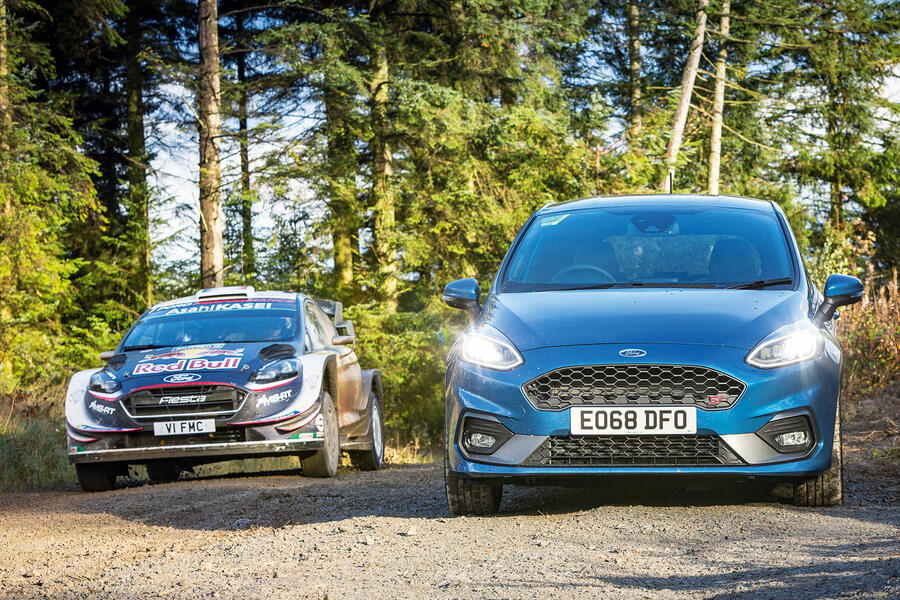
Second Opinion
There’s a tremendous amount to like, but not the drive modes. They complicate what should be simple. The noise is contrived, the steering given unwanted additional weight and the throttle made too snatchy. When I can pinch the ST from Sam, it stays in Normal – and it’s great.
Matt Bird
Ford Fiesta ST-3 specification
Specs: Price New £21,495 Price as tested £24,515 OptionsPerformance Blue £745, full LED headlights £600, blind spot information system £475, ST Performance Pack £850, B&O Play premium audio system £350
Test Data: Engine 3 cylinder, 1500cc, turbocharged petrol Power 197bhp at 6000rpm Torque 214lb ft at 1600-4000rpm Kerb weight 1262kg Top speed 144mph 0-62mph 6.5sec Fuel economy 47.1mpg CO2 136g/km Faults None Expenses None
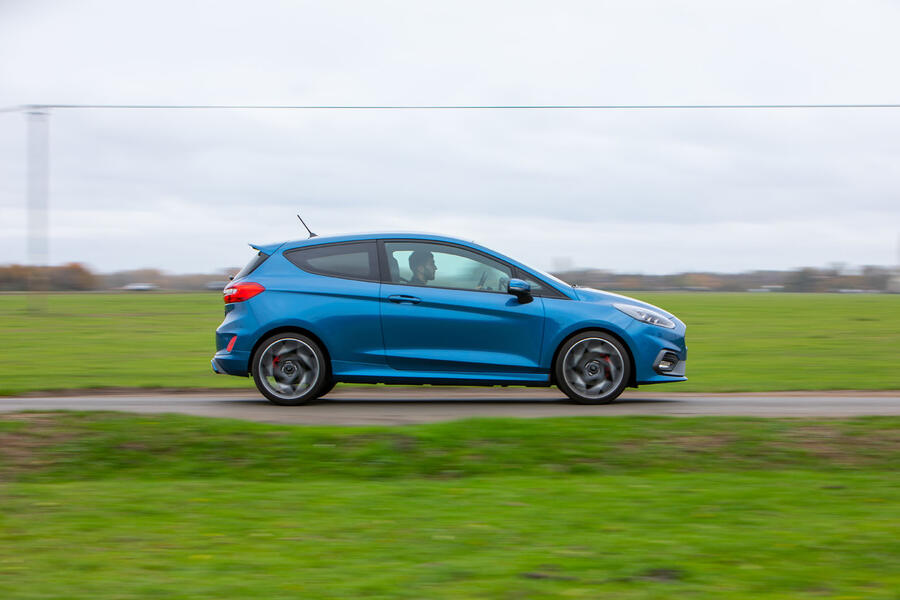
Comments
Post a Comment